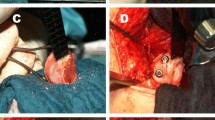Abstract
A 4-U hybrid total hip arthroplasty (THA) system was specifically designed for patients with developmental dysplasia of the hip (DDH). Straight stem with an appropriate offset and various size variations are advantages. We followed 128 hips in 124 patients, 13 men and 111 women, for a mean of 6.5 years (range, 5.0–7.5 years). Two acetabular and femoral components in two patients had been revised for infection, one acetabular component had been revised for recurrent dislocation, and one femoral component had been revised for periprosthetic femoral fracture. None of the acetabular or femoral components were revised for loosening or were found to be loose at follow-up. The Harris hip score increased from a preoperative average of 42 points to 88 points at the most recent follow-up. Primary THA using the 4-U system had a good mid-term result in patients with DDH. This system could be applied for all patients including those with the narrowest and deformed femurs.



Similar content being viewed by others
References
Biant LC, Bruce WJ, Assini JB, Walker PM, Walsh WR (2009) Primary total hip arthroplasty in severe developmental dysplasia of the hip: ten-year results using a cementless modular stem. J Arthroplasty 24:27–32
Bicanic G, Delimar D, Delimar M, Pecina M (2009) Influence of the acetabular cup position on hip load during arthroplasty in hip dysplasia. Int Orthop 33:397–402
DeLee JG, Charnley J (1976) Radiographical demarcation of cemented sockets in total hip replacement. Clin Orthop Relat Res 121:20–32
Delimar D, Bićanić G, Pećina M, Korzinek K (2004) Acetabular roof reconstruction with pedicled iliac graft: early clinical experience. Int Orthop 28:319–320
Delimar D, Cicak N, Klobucar H, Pećina M, Korzinek K (2002) Acetabular roof reconstruction with pedicled iliac graft. Int Orthop 26:344–348
Ebramzadeh E, Sarmiento A, McKellop HA, Linas A, Gogan W (1994) The cement mantle in total hip arthroplasty: analysis of long-term radiographic results. J Bone Joint Surg Am 76:77–87
Gruen TA, McNeice GM, Amstutz HC (1979) “Modes of failure” of cemented stem-type femoral components: a radiographic analysis of loosening. Clin Orthop Relat Res 141:17–27
Harris WH (1969) Traumatic arthritis of the hip after dislocation and acetabular fracture: treatment by mold arthroplasty. J Bone Joint Surg Am 51:737–755
Harris WH, McCarthy JC Jr, O'Neill DA (1982) Femoral component loosening using contemporary techniques of femoral cement fixation. J Bone Joint Surg Am 64:1063–1067
Hartofilakidis G, Stamos K, Karachalios T, Ioannidis TT, Zacharakis N (1996) Congenital hip disease in adults: classification of acetabular deficiencies and operative treatment with acetabuloplasty combined with total hip arthroplasty. J Bone Joint Surg Am 78:683–692
Higa M (2003) Development of a new femoral component in total hip arthroplasty. PhD Dissertation, Hokkaido University, Sapporo, Japan, pp 75–86
Ito H, Matsuno T, Minami A, Aoki Y (2003) Intermediate-term results after hybrid total hip arthroplasty for the treatment of dysplastic hips. J Bone Joint Surg Am 85:1725–1732
Kobayashi S, Terayama K (1992) Factors influencing survivorship of the femoral component after primary low-friction hip arthroplasty. J Arthroplasty 7 Suppl:327–338
Langlais F, Kerboull M, Sedel L, Ling RSM (2003) Annotation: the ‘French paradox’. J Bone Joint Surg Br 85:17–20
Livermore J, Ilstrup D, Morrey B (1990) Effect of femoral head size on wear of the polyethylene acetabular component. J Bone Joint Surg Am 72:518–528
Mallory TH, Lombardi AV Jr, Fada RA, Herrington SM, Eberle RW (1999) Dislocation after total hip arthroplasty using the anterolateral abductor split approach. Clin Orthop Relat Res 358:166–172
Mulroy WF, Estok DM, Harris WH (1995) Total hip arthroplasty with use of so-called second-generation cementing techniques: a fifteen-year-average follow-up study. J Bone Joint Surg Am 77:1845–1852
Kuramoto K (2003) Strength test of the femoral neck. Technical Report of Nakashima Medical Co. Okayama
Noble PC, Kamaric E, Sugano N et al (2003) Three-dimensional shape of the dysplastic femur: implications for THR. Clin Orthop Relat Res 417:27–40
Perka C, Fischer U, Taylor WR, Matziolis G (2004) Developmental hip dysplasia treated with total hip arthroplasty with a straight stem and a threaded cup. J Bone Joint Surg Am 86:312–319
Postel M (1987) The routine operation. In: Postel M, Kerboull M, Evrard J, Courpied JP (eds) Total hip replacement. Springer, Berlin, pp 26–33
Pradhan R (1999) Planar anteversion of the acetabular cup as determined from plain anteroposterior radiographs. J Bone Joint Surg Br 81:431–435
Ramaniraka NA, Rakotomanana LR, Leyvraz P-F (2000) The fixation of the cemented femoral component: effects of stem stiffness, cement thickness and roughness of the cement/bone surface. J Bone Joint Surg Br 82:297–303
Russotti GM, Harris WH (1991) Proximal placement of the acetabular component in total hip arthroplasty: a long-term follow-up study. J Bone Joint Surg Am 73:587–592
Shen B, Yang J, Wang L et al (2009) Midterm results of hybrid total hip arthroplasty for treatment of osteoarthritis secondary to developmental dysplasia of the hip—Chinese experience. J Arthroplasty 24:1157–1163
Skinner JA, Todo S, Taylor M et al (2003) Should the cement mantle around the femoral component be thick or thin? J Bone Joint Surg Br 85:45–51
Sugano N, Noble PC, Kamaric E et al (1998) The morphology of the femur in developmental dysplasia of the hip. J Bone Joint Surg Br 80:711–719
Valdivia GG, Dunbar MJ, Parker DA et al (2001) Three-dimensional analysis of the cement mantle in total hip arthroplasty. Clin Orthop Relat Res 393:38–51
Conflict of interest and funding
No benefits or funds were received in support of this study.
Author information
Authors and Affiliations
Corresponding author
Rights and permissions
About this article
Cite this article
Ito, H., Tanino, H., Yamanaka, Y. et al. Hybrid total hip arthroplasty using specifically-designed stems for patients with developmental dysplasia of the hip. A minimum five-year follow-up study. International Orthopaedics (SICOT) 35, 1289–1294 (2011). https://doi.org/10.1007/s00264-010-1096-3
Received:
Revised:
Accepted:
Published:
Issue Date:
DOI: https://doi.org/10.1007/s00264-010-1096-3



